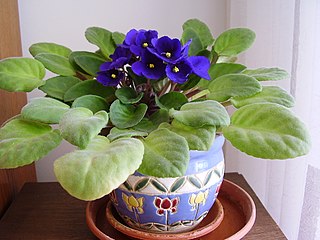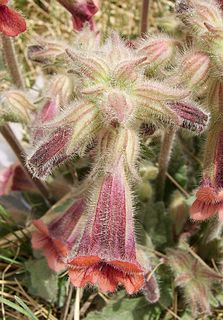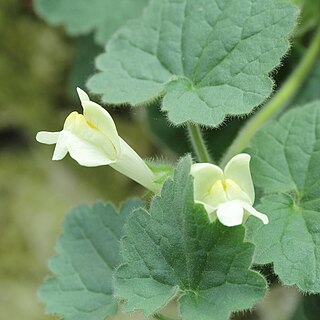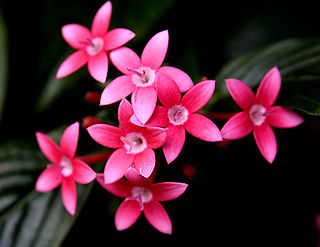
The Scrophulariaceae are a family of flowering plants, commonly known as the figwort family. The plants are annual and perennial herbs, as well as one genus of shrubs. Flowers have bilateral (zygomorphic) or rarely radial (actinomorphic) symmetry. The Scrophulariaceae have a cosmopolitan distribution, with the majority found in temperate areas, including tropical mountains. The family name is based on the name of the included genus Scrophularia L.

Gesneriaceae, the gesneriad family, is a family of flowering plants consisting of about 152 genera and ca. 3,540 species in the tropics and subtropics of the Old World and the New World, with a very small number extending to temperate areas. Many species have colorful and showy flowers and are cultivated as ornamental plants.

Phrymaceae, also known as the lopseed family, is a small family of flowering plants in the order Lamiales. It has a nearly cosmopolitan distribution, but is concentrated in two centers of diversity, one in Australia, the other in western North America. Members of this family occur in diverse habitats, including deserts, river banks and mountains.

Rehmannia is a genus of six species of flowering plants in the order Lamiales and family Orobanchaceae, endemic to China. It is the only member of the monotypic tribe Rehmannieae. Contrary to the immense majority of the taxa of Orobanchaceae, Rehmannia is not parasitic.

Chaenostoma cordatum, also known by the names bacopa or ornamental bacopa, is one of 52 species in the genus Chaenostoma (Scrophulariaceae), and is best known in its cultivated forms. It originated in Southern Africa, and is a tender perennial forming a ground cover, but often used in hanging baskets. Small dark green heart shaped leaves and small round five-petaled blue, pink, or white flowers at the branch tips can be found year-round, but at its prime in spring.
Bullockia is a genus of flowering plants in the family Rubiaceae. It was originally described as a subgenus of Canthium. The genus is distributed in eastern and southern Africa from Ethiopia to Transvaal, as well as Madagascar in bushland, woodland, savannas, and dry, deciduous forests.

Canthium is a genus of flowering plants in the family Rubiaceae. They are shrubs and small trees. The leaves are deciduous and the stems are usually thorny.

Diascia is a genus of around 70 species of herbaceous annual and perennial flowering plants of the family Scrophulariaceae, native to southern Africa, including South Africa, Lesotho and neighbouring areas.

Vanguerieae is a tribe of flowering plants in the family Rubiaceae and contains about 655 species in 30 genera. It is one of the most species-rich groups within the family and it is distributed all over the Paleotropics.

Asarina is a flowering plant genus of only one species, Asarina procumbens, the trailing snapdragon, which is native to southern Europe. Originally placed in the Scrophulariaceae, the genus has more recently been moved to the Plantaginaceae. Species from North America formerly placed in the genus Asarina are now placed in Holmgrenanthe, Lophospermum, Mabrya and Maurandya, as well as Neogaerrhinum. Asarina is now regarded as exclusively an Old World genus.

Jamesbrittenia ramosissima is a Southern African shrub in the family Scrophulariaceae occurring in the Northern Cape and southern Namibia, westward along the Gariep River from the vicinity of Augrabies Falls. It is one of some 90 species in the genus Jamesbrittenia, ranging through Africa, with 74 species occurring in Southern Africa, and 1 in India. The genus is named for James Britten (1846-1924), medical student turned botanist, and acting Keeper of Botany at the British Museum when Kuntze named it.

Knoxieae is a tribe of flowering plants in the family Rubiaceae and contains about 131 species in 16 genera. Its representatives are found in Tropical and Southern Africa, the islands in the Western Indian Ocean, the Arabian Peninsula, Tropical and Subtropical Asia, and Northern Australia.
Johann Rudolf Suter was a Swiss physician, botanist and philologist.
Birgitta Bremer, Swedish botanist and academic, is professor at Stockholm University, and director of the Bergius Botanic Garden.

Mickelopteris is a genus of ferns in the subfamily Cheilanthoideae of the family Pteridaceae with a single species Mickelopteris cordata. Synonyms include Parahemionitis cordata and Hemionitis cordataRoxb. ex Hook. & Grev. The species is native to south-eastern Asia, from India to Taiwan and the Philippines.

Barthlottia madagascariensis is the only species in the genus Barthlottia of flowering plants in the family Scrophulariaceae. The large shrub with conspicuous purple flowers is native to a very restricted area in southeast Madagascar and was described in 1996.
Hemimeris is a genus of flowering plants in the family Scrophulariaceae, native to the Cape Provinces of South Africa. They secrete oils to attract specialized oil-collecting bees from the genus Rediviva.
Chaenostoma is a genus of flowering plants belonging to the family Scrophulariaceae.
Nichallea is a monotypic genus of flowering plants belonging to the family Rubiaceae. It only contains one species, Nichallea soyauxii(Hiern) Bridson














